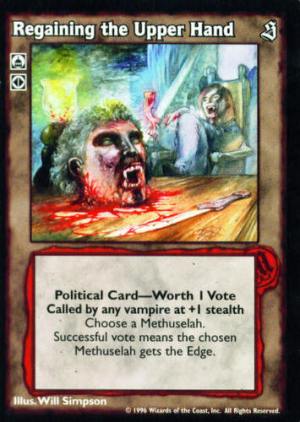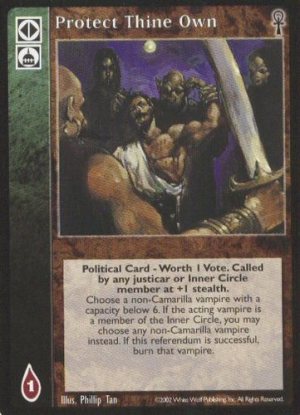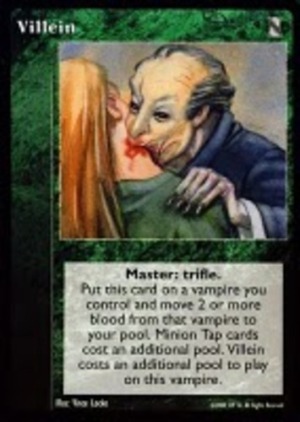Greetings Methuselahs!
With the new Anarch set right around the corner, I thought it would be a good time to talk about virtual sets in general and how they are designed in specific. Now, I’m not talking about the very important process of figuring out how to design cards that to prop up struggling clans / disciplines, or tone down strong clans / disciplines. Instead, I want to talk about how balanced a new card should be.
Now I think we can agree that in a perfect world, all cards in the game would be different yet balanced: that each effect offered by a discipline would all be equally useful in your path to victory. But it’s quite clear that we don’t live in a perfect world and the idea that somebody could create hundreds of perfectly balanced, equally useful cards is somewhat absurd. Each facet of the game presents a possible inequality. So the only real way to create perfectly balanced cards is to make them all the same. What a boring game that would be!

The impossibility of true balance means that card games need to aim to have their cards fall into a range of power with the expectation that as long as most cards fit into this range, that the game will be relatively well balanced. VTES presents some particularly nasty challenges to creating balanced cards. First, it’s a multi-player game where even perfectly balanced (aka identical) cards might not result in balanced game-play due to several players attacking one. Second, the game includes many systems and sub-systems, many of which have extremely different impacts on the game. This makes it relatively easy to compare the power of two combat cards or two political actions, but very difficult to think about how powerful a combat card is in relation to a political action.
For any game, cards whose power level falls significantly below this balanced power range pose little to no problem to the balance of the game – these cards simply don’t get played. Consider Regaining the Upper Hand – do you even remember what it does? I’ve never seen it played before. Hell, I’m one of those players who has an irrational desire to play bad cards and I’ve never even considered putting it into a deck. But is the presence of this extremely underpowered card bad for the game? Well, players might stop buying your cards if they all suck, but the balance of the game isn’t really impacted.

Contrast this to cards that are significantly more powerful than the “balanced” power range. Let’s consider Protect Thine Own – a card that allows you to turn 1 blood into a burned vampire. Well, they can’t be a Camarilla vampire, but since only about a third of the major clans belong to the Camarilla, it’s not very difficult to find targets. This card was clearly designed to try to encourage people into playing with inner circle members during a time when vampires with capacity 9 or above were out of favor, but it caused a massive problem with the game. I consider myself fortunate to have started the game after this card was banned. Cards like this are a major problem for a game at all levels because they create bad play experiences. That’s the very best way I can think of to lose players. Table rearranging cards like Dramatic Upheaval produce similar results, which undoubtedly contributed to their mass banning.
This means that if you are designing a new card, you have a power level that you are aiming for – that balanced power range. But you know that if you miss the mark and your card is too powerful, you could irrevocably damage the game. If the card turns out to be too weak, then at worst you’ve made people roll their eyes and not buy one set. Looking at these options, I know exactly what I would do as a game designer – aim to get all my cards in the lower end of that balanced power range. That way, if a card ends up missing the mark a little, it will either be useless, or it will end up being on the strong end of balanced.
I think this safe and cautious approach is actually the right strategy for most situations due to one simple reason: nobody likes errata. Nobody likes having a card that says X, but does Y. Especially when the change is significant. It’s one matter to tell a player that Majesty always costs a blood, and quite another to tell them that Derange is now a clan card and you pretty much just have to pull out your phone to check the current text. That’s a situation that everybody wants to avoid, and consequentially errata is employed only for the very worst offenders of game balance or for cards that are supremely confusing. Slightly too powerful cards (yeah, I’m looking at you, Parity Shift) are left alone because the downsides of issuing errata is worse for the game than the slight imbalanced cause by the power level of the card.
An interesting thought experiment is what might happen if errata were used to make cards better. Think of how interesting Regaining the Upper Hand could be if it received a power bump (maybe a mini Kine Resources Contested plus you gain the edge?). But a company would never think of doing this because the small benefit given to players (providing people with a stronger card) is far outweighed by the negatives (“no seriously, this card actually does something different than it says!”). The company would be far better off taking their idea for the improved card and just printing a new one that people would then have to buy.

But how does this all apply to digital sets? Since no physical product is ever released, the downside to issuing errata is reduced to the minor inconvenience of printing new cards. We haven’t seen any errata (that I know of) on the VEKN designed cards yet, but I’d wager that there would be significantly less resistance from the community to issuing errata for a digital card as opposed to changing something like Parity Shift. Hell, just look at how long it took the VEKN to errata Villein so that people could actually play Minion Tap again! And, as I’ve argued above, the problems surrounding errata of overly strong cards is the primary reason for the cautious card design philosophy. This may mean that the digital sets don’t have to be designed with the same philosophy in mind.
What reasonable alternatives exists to the cautious card design philosophy? Well, instead of aiming for the lower side of the balanced power range, why not aim for the upper end? If you hit your mark, you’ve created a strong, but balanced card that players will want to play with and may help shake up the game and keep it fresh. If you miss, you either create a well balanced card that will see some play or you create an insanely overpowered card that you will have to quickly errata. This is what I call the reckless card design philosophy. And it’s important to note that this doesn’t encourage designers to create cards overpowered cards any more than the cautious philosophy encourages designers to make wallpaper cards. Rather, the reckless philosophy suggests that cards should aim to be of moderate to high power rather than low to moderate power.
Now, clearly this design philosophy isn’t ideal when designing cards for popular or powerful strategies. I certainly wouldn’t want anybody to be reckless when designing a Dominate/Protean card to help out Stanisalava, for instance! In fact, I think I’d prefer the designers to touch Dominate with a great deal of caution – adding anything more to that discipline could be dangerous.
So, why would anybody want to use the reckless philosophy? Well, individual cards have more impact on the game, which makes it particularly good for small sets. It is also of particular value when designing for historically underutilized play styles or themes. The anarchs are actually a great example – although they have two entire sets specifically devoted to them, they remain a very minor part of the game. People simply don’t play them because it’s difficult to become an anarch, and once you do, the cards you have available just aren’t that strong. Introducing some cards with above-average power could really help shore up an otherwise unremarkable mechanic.
I think if it were up to me, I would encourage the design team to be a little reckless, particularly when designing cards for mechanics like the anarchs, red list, or the Sabbat (who seem to have been the red-headed stepchild faction for a long time). Which design philosophy do you prefer for a digital set? How would you feel if the VEKN released a card, and then issued errata for it only a few months later? Are there other design philosophies that you particularly like? Post your comments below!
Until next time, may your bleeds never be bounced and all your votes pass!
Brett
I agree 100%. The game has been unballanced since KoT took a “reckless approach” which significantly boosted the strength of the already strong Camarilla. I think a little reckless is okay because it makes the game interesting and helps it evolve. There is simply no point in creating new cards that aren’t good enough to see play. But the reason it was unbalancing was because the other sects never got their aggressive set, and as I see it this is basically what the VEKN sets are trying to address. The anarchs definitely need some strong cards to make it worth while going anarch. As I see it, they really only have two excellent cards: Anarch Revolt and Anarch Convert, and the second is a crypt card. Also Anarch Free Press and Anarch Railroad have good value although they aren’t that strong. But the multi-discipline cards are very difficult to use. I hardly ever seen them played at all, especially in the way they were intended.
Also, with proper playtesting, even taking the “reckless approach” you should be able to avoid creating totally unbalanced cards. Personally, the number one card I think should be banned is Temptation of Greater Power. Cards that just hose your deck from the start of the game and never let you play your game are not fun.
LikeLiked by 1 person
Yeah, I agree with you in regards to the Anarchs – they just haven’t been very strong, and it will be interesting to see if the new cards help them along or not. Really, I think there is no reason to print an Anarch card that doesn’t significantly help the archetype. I would also really like to see errata used a little more in regards to the digital cards. Maybe something like Public Vilification that doesn’t see much play (that I know of) could get changed to make it more powerful. Seems to make sense when the largest limiting factor (in my totally uneducated estimation) is the artwork. Speaking of, I should really do an art review blog for the new cards. I’m shocked at how great the art has been – especially since I assume there is no or very little money changing hands. Such passion for the game!
LikeLike
when designing digital cards it makes no sense to me to introduce cards that wouldn’t see play. Because of it those cards should aim at moderate to high power or be otherwise interesting to see play in casual games. On the other hand carefull playtesting of those is REALLY important. Digital cards are technically easy to introduce changes on them but such changes would harm Design Team credibility. Digital sets are already controversial because of their form. If we add some careless approach to it, design overpowered cards just to errata them most players will start to view them as low quality and stop using at all.
LikeLiked by 1 person
Now that is an excellent point. I didn’t think about the credibility of the design team, and you are correct that it is absolutely essential that they maintain that with the community. Very nice point!
LikeLike